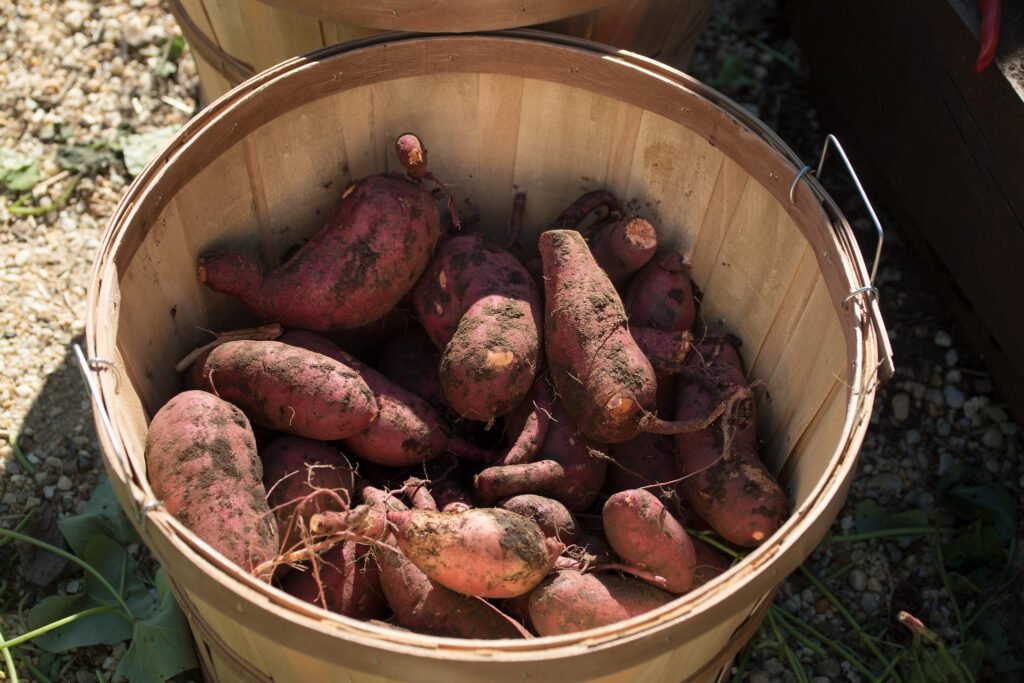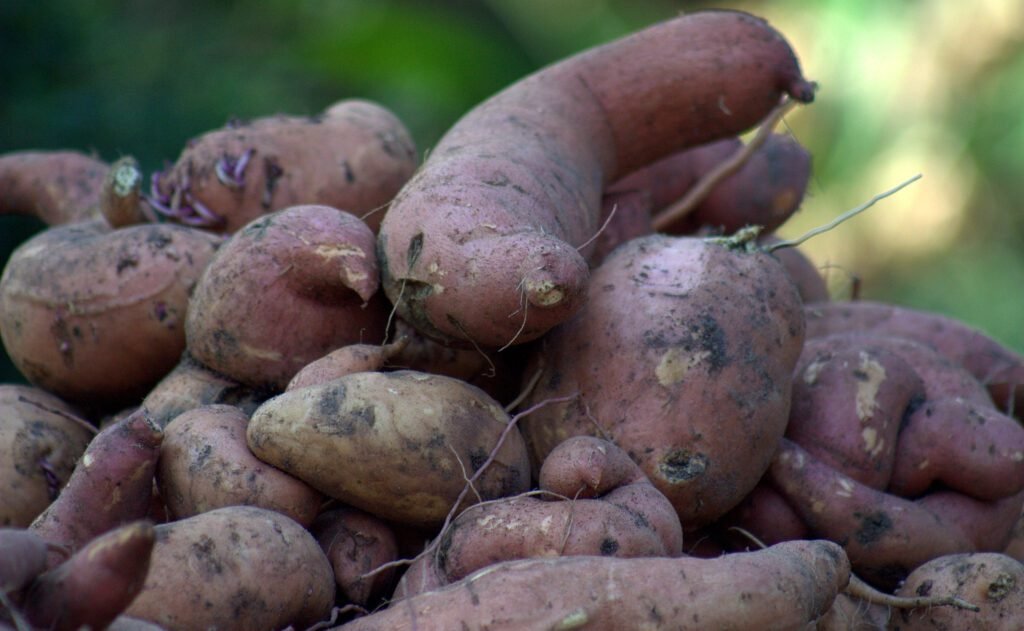Growing sweet potatoes in Colorado can be a rewarding experience, offering you a delicious and nutritious harvest. Understanding Colorado’s unique climate is key to success. This guide on how to grow sweet potatoes in Colorado will provide you with all the essential steps to plant, care for, and harvest your sweet potatoes, ensuring a bountiful yield.
Understanding Sweet Potatoes
Sweet Potatoes vs. Yams: Know the Difference
Before diving into the planting process, it’s important to distinguish between sweet potatoes and yams. Sweet potatoes have a smooth skin that ranges from white to yellow, orange, or even purple. The sweetness in flavor and moist texture when cooked makes it different from yams. Yams, on the other hand, have rough, bark-like skin and can be less sweet with a starchy texture. Understanding these differences ensures you select the right tuber for your garden.
Nutritional Benefits of Sweet Potatoes
Sweet potatoes are not just delicious; they are packed with essential nutrients. One medium sweet potato provides a good source of vitamin A, vitamin C, fiber, and antioxidants. These nutrients help one in keeping healthy, boosting immune system, and reducing inflammation.
Choosing the Right Varieties for Colorado
Selecting the right variety is crucial for success when growing sweet potatoes in Colorado. Some popular varieties include:
- Beauregard: Known for its high yield and sweet flavor, this variety has reddish skin and bright orange flesh.
- Georgia Jet: This variety is well-suited for Colorado’s climate, with creamy white flesh and a slightly nutty flavor.
- Evangeline: With deep purple skin and light-yellow flesh, Evangeline is a high-yielding variety that offers a sweet taste.
Preparing for Planting
When to Plant Potatoes in Colorado
Timing is everything when it comes to planting sweet potatoes in Colorado. The best time to plant is from late spring to early summer, typically around early June. This ensures that the plants have enough warm weather to grow before the cooler temperatures of autumn arrive.
Selecting the Ideal Site
Choose a location with full sun exposure and well-drained soil. Sweet potatoes need plenty of sunlight, ideally at least 8 hours per day, to thrive. Ensuring the soil is loose and well-aerated will help the roots develop properly.
Soil Preparation
Sweet potatoes prefer slightly acidic soil with a pH between 5.5 and 6.5. Test your soil and amend it as necessary. Mixing in compost and furthermore organic materials can help in boosting soil health, making it richer and more nutritious for your plants.
Planting Sweet Potatoes in Colorado
Starting with Slips
Sweet potatoes are grown from slips, which are small shoots that sprout from a mature sweet potato. You can purchase slips from a reputable vendor or start your own indoors. Place a mature sweet potato in a container with soil, keeping it warm and moist until slips develop.
Transplanting Slips Outdoors
Once the slips are about 6-12 inches long, they are ready to be transplanted outdoors. Plant each slip 4-6 inches deep and 12-20 inches apart. Water thoroughly after planting to help the slips establish.
Nurturing Your Sweet Potato Plants
Watering Requirements
Sweet potatoes need consistent moisture, but it’s important to avoid waterlogging the soil. Water the plants regularly, ensuring the soil stays moist but not soggy. Mulching can help retain moisture and suppress weeds.
Fertilizing for Optimal Growth
Sweet potatoes benefit from a balanced fertilizer, especially one that is high in phosphorus. Apply fertilizer two to three weeks after planting and then every month until August. This will support the development of healthy roots and tubers.
Weed Management and Mulching
Weeds can compete with sweet potatoes for nutrients and water. If one regularly performs the process of weeding and the use of mulch, it can help in preventing weeds and maintain soil moisture. Organic mulch, such as straw or leaves, is ideal for this purpose.
Pest and Disease Control
Several pests can affect sweet potatoes in Colorado, including beetles, aphids, and leafhoppers. These insects can damage the foliage and reduce yields.
Disease Prevention
Sweet potatoes are susceptible to fungal and bacterial diseases such as black rot and bacterial leaf spots. To prevent these diseases, practice crop rotation, ensure proper spacing between plants for good air circulation, and remove any diseased plant material promptly.
Organic Control Methods
Using organic methods such as companion planting, beneficial insects, and organic pesticides can help control pests and diseases. Ladybugs and green lacewings are excellent natural predators for many common sweet potato pests
Managing Sweet Potato Vines
Training and Pruning Vines
Sweet potato vines can grow rapidly and cover a large area. Training the vines over mounds or ridges can improve air circulation and reduce disease risk. Pinching back vines that grow too long helps the plant focus its energy on tuber production.
Benefits of Vine Management
Proper vine management can lead to higher yields and better-quality tubers. By controlling the growth of the vines, you ensure that the plant’s resources are directed towards producing larger and sweeter sweet potatoes.
Harvesting and Storing Sweet Potatoes

When to Harvest Sweet Potatoes ?
Sweet potatoes are typically ready for harvest from September to October. The foliage will start to yellow and die back, indicating that the tubers are mature.
How to Harvest Sweet Potatoes ?
Carefully dig around each plant to avoid damaging the tubers. Use a garden fork or spade to lift the tubers from the soil. Handle them gently to prevent bruising.
Curing and Storing Sweet Potatoes
After harvesting, cure the sweet potatoes in a warm, humid environment for about two weeks. This process enhances their sweetness and extends their shelf life. Store cured sweet potatoes in a cool, dark place with good ventilation.
Overcoming Colorado’s Climate Challenges
Using Raised Beds and Hoop Houses
Raised beds and hoop houses can help extend the growing season by providing a warmer environment for your sweet potatoes. Raised beds improve drainage and soil warmth, while hoop houses protect plants from temperature fluctuations.
Monitoring Weather Conditions
Keep an eye on the weather forecast and be prepared to protect your plants from extreme temperatures or unexpected frosts. Using row covers or thermal blankets can help shield your sweet potatoes during cold snaps.
Your Sweet Potato Journey
Growing sweet potatoes in Colorado might come with its challenges, but the rewards are well worth it. Choose the right varieties, prepare your soil with care, and maintain consistent care to reap a plentiful harvest of tasty and nutritious sweet potatoes. if you follow these tips and strategies in this guide, and you’ll be well on your way to growing a great crop of sweet potatoes.
Can I grow sweet potatoes in Colorado?
Yes, you can grow sweet potatoes in Colorado by selecting suitable varieties, planting at the right time, and providing proper care and maintenance.
When is the best time to plant potatoes in Colorado?
The best time to plant sweet potatoes in Colorado is from late spring to early summer, around early June.
How do I prepare the soil for planting sweet potatoes?
Sweet potatoes prefer slightly acidic, well-drained soil. Test your soil’s pH and amend it with compost or other organic matter to improve its structure and fertility.
How do I prevent pests and diseases in my sweet potato garden?
Practice crop rotation, use organic control methods, and ensure proper spacing between plants to prevent pests and diseases. Regularly inspect your plants and remove any affected foliage.
What are the best sweet potato varieties for Colorado?
Some of the best varieties for Colorado include Beauregard, Georgia Jet, and Evangeline, which are well-suited to the local climate and soil conditions.

Pingback: How to Grow Potatoes in Texas: A Complete Guide